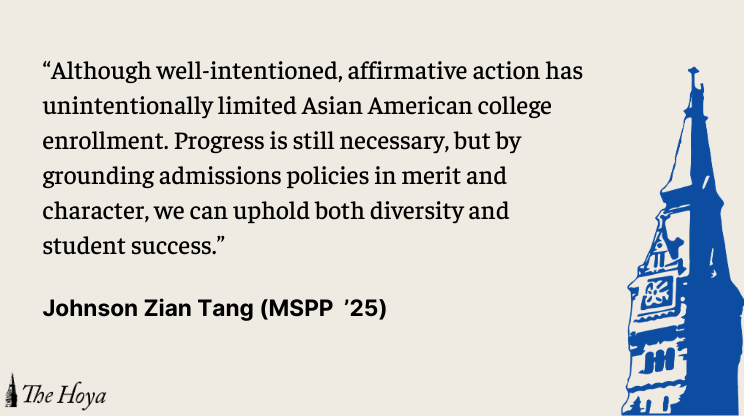On June 29, 2023, the Supreme Court overturned affirmative action — a policy that aims to increase opportunities for underrepresented groups by explicitly considering race and ethnicity — a historic, controversial and sweeping ruling.
Affirmative action was born out of the civil rights era and remained one of the major achievements of the period. The practice became especially prevalent in the college admissions and job recruitment processes in 1978 after the Supreme Court upheld race-conscious admissions in Regents of the University of California v. Bakke.
At the advent of affirmative action, Asian Americans were intended to benefit from the practice. Before the rise of high-performing Asian economies in the late nineteenth century, many Asian American communities had been socioeconomically homogeneous.
Despite their cultural and ethnic diversity, many of these communities shared similar characteristics — namely that they were comprised of first-generation immigrants who moved to the United States, seeking asylum from poverty, war and famine. Since many first-generation immigrants lacked formal higher education, affirmative action was believed to grant Asian Americans newfound access to education, and thus, social mobility.
Asian Americans and Asian international students initially benefited from affirmative action to enroll in preferable colleges, despite language barriers, economic disadvantages and a lack of generational education.
However, the split among Asian communities in the late twentieth century greatly changed how affirmative action impacted Asian American students. At the dawn of the 1980s, the rise of Japan and South Korea made these two ethnic communities rise out of impoverished circumstances. Meanwhile, the economic development of China and India significantly changed the immigrant demography by creating a divide between “older” immigrants, who stuck with blue-collar jobs, and new immigrants, who began to take up positions on Wall Street and in Silicon Valley upon graduation from elite American colleges.
Although these “new immigrants” flourished, other Asian communities, such as the Burmese, Bangladeshis and Cambodians, continued to face financial challenges, which hindered their ability to attain higher education.
As a result of this disparity in economic development, rather than “aiding” Asian Americans, affirmative action forced colleges to narrow their racial quota for all Asian American students. Certain ethnicities within this group, such as the Chinese and Indians, began to dominate college admissions, with a trend of higher standardized scores, stronger GPAs and more diversified extracurricular activities.
Asian American applicants consequently needed to perform at higher academic levels to be admitted to the same class of colleges as their Black, Latinx or even white peers. For instance, in 2015, Asian American applicants scored, on average, 78 points higher on the SAT than any other racial group.
Even in financially privileged Asian communities, such as the Chinese, Indian and Korean communities, the ability to afford extensive college preparation resources does not undermine the need to vastly outperform other races in pursuit of higher education in the United States.
Rather than a measurement to promote racial equality, affirmative action’s tendency toward certain races deemed to “need help” has turned into entrenching racist generalizations about the Asian American community.
Instead of a system that dictates that certain races need assistance, a true diversity-enhancing policy would be more efficient if colleges worked directly with College Board and ACT organizers to make adjustments to their test questions. The College Board and ACT should devise tests that contain questions of varying difficulty based on educational quality and financial circumstances in the test-taker’s area.
This policy would necessitate complex coordination between the College Board, universities and even the government, but it would be a positive change that incorporates the purpose of affirmative action — diversity and equity of opportunity — without unfairly discriminating against Asian Americans.
Although well-intentioned, affirmative action has unintentionally limited Asian American college enrollment. Progress is still necessary, but by grounding admissions policies in merit and character, we can uphold both diversity and student success. The United States has long been a land of opportunity. By promoting fairness in our systems, we can ensure it continues to be a land of opportunity, where ambitious students of all backgrounds can realize their full potential.
Johnson Zian Tang is a first-year student in the McCourt School of Public Policy.














